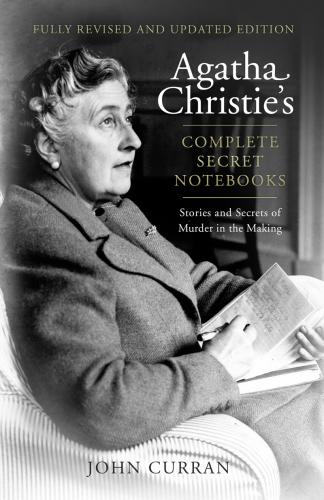Ronnie West (debonair Peter Wimseyish)
Agatha Christie in the Notebooks
Christie several times references herself and her work in the Notebooks. For some reason she twice – in Notebooks 72 and 39 – lists some of her books, although the lists are not exhaustive nor is it obvious what the titles have in common; and she often refers to earlier titles as a quick reminder.
Hotels – Body in Library, Evil under the Sun
Trains Aeroplanes – Blue Train, Orient Express, Death in Clouds, Nile
Private Life (country) Towards Zero, Hollow, Xmas, 3 Act Tragedy, Sad Cypress
(village) Vicarage, Moving Finger Travel – Appointment with Death
This list appears just after notes for Mrs McGinty’s Dead. The fact that Taken at the Flood does not appear in the list may mean that it was compiled in late 1946, after The Hollow, or early 1947, before Taken at the Flood was completed. From the headings it would seem that she was considering backgrounds previously used.
Murder on Nile
Death in Clouds
Murder in Mesopotamia
Orient Express
Appointment with Death
Tragedy in 3 Acts
Dead Man’s Mirror
And the above, squeezed into the corner of a page during the plotting of Evil under the Sun, is even more enigmatic. Apart from the fact that they are all Poirot stories, it is difficult to see what they have in common.
The next musing appears in the notes for Towards Zero. Wisely, she decided against it as another mysterious death at the hotel in the space of three years could look, in Oscar Wilde’s famous phrase, like carelessness:
The following odd, and inaccurate, reference – Poirot was not involved in the case – to an earlier killer appears in the notes for Elephants Can Remember.
This was among the last notes to appear, written just before the publication of Postern of Fate:
First one – The White Horse Party (rather similar to Jane Marple’s Tuesday Night Club)
Chapter 25 of 4.50 from Paddington includes a brief, cryptic reference to A Murder is Announced, but without mentioning the title …
… while this reference appears during the plotting of Third Girl:
Finally, the idea of reintroducing Sergeant Fletcher from A Murder is Announced was briefly considered during the plotting of A Pocket Full of Rye:
‘It was while I was working in the dispensary that I first conceived the idea of writing a detective story.’
An Autobiography
SOLUTIONS REVEALED
After the Funeral • Appointment With Death • Death in the Clouds • The Man in the Brown Suit • The Mysterious Affair at Styles • The Mystery of the Blue Train • ‘The Red Signal’ • The Secret of Chimneys
The Mysterious Affair at Styles was published in the USA at the end of 1920 and in the UK on 21 January 1921. It is a classic country-house whodunit, a setting and form destined to become synonymous with the name of Agatha Christie. Ironically, over the following decade she wrote only one more ‘English’ domestic whodunit, The Murder of Roger Ackroyd (1926). The other two whodunits of this decade are set abroad: The Murder on the Links (1923) is set in Deauville, France and The Mystery of the Blue Train (1928) has a similar South of France background. With the exception of the last title, which Christie, according to An Autobiography, ‘always hated’ and had ‘never been proud of’, they are first-class examples of the classic detective story then entering its Golden Age. Each title, with the same exception, displays the gifts that would later make Agatha Christie the Queen of Crime – uncomplicated language briskly telling a cleverly constructed story, easily recognisable and clearly delineated characters, inventive plots with all the necessary clues given to the reader, and an unexpected killer unmasked in the last chapter. These hallmarks would continue to be a feature of Christie’s books until the twilight of her career, half a century later.
The rest of her novels of the 1920s consist of thrillers, both domestic – The Secret Adversary (1922), The Secret of Chimneys (1925) and The Seven Dials Mystery (1929) – and international – The Man in the Brown Suit (1924). While none of these titles are first-rate Christie, they all exhibit some elements that would appear in later titles. The Secret Adversary, the first Tommy and Tuppence adventure, unmasks the least likely suspect while The Man in the Brown Suit is an early experiment with the famous Roger Ackroyd conjuring trick. The Seven Dials Mystery subverts reader expectation of the ‘secret society’ plot device and The Secret of Chimneys, a light-hearted mixture of missing jewels, international intrigue, incriminating letters, blackmail and murder in a high society setting, shows early experimentation with impersonation and false identity.
Throughout the 1920s Christie’s short story output was impressive, with three such collections published in the decade. The contents of Poirot Investigates (1924) first appeared in The Sketch, in a commissioned
